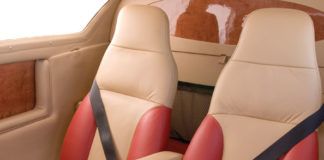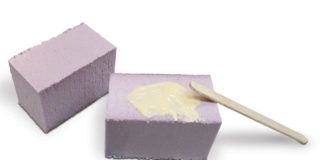Most of us began our journey into the sky as sport aviators by first imagining ourselves there. Open cockpit, flying low, enjoying the scenery—those are the things that attract most people. That is even true for pilots who got their start in heavier metal. Whether pilots fly at 3000 feet or 30,000 feet, they often suspect that the real fun is down around 500 feet—and of course, they’re right.
So while conventional pilots are proud of the destinations they have traveled to in their aircraft, sport aviators seem more proud of what they have flown over. It’s all aviation and it’s all good, but low and slow really is more experience based than process based.

Fly an ultralight and see the world. This year the World Microlight Championships will be held outside Segovia, Spain.
If you are looking for that next experience-based adventure, why not take an overseas vacation and do some ultralight flying while you’re at it? Better yet, why not join a lot of flying friends and share the skies with them?
The problem is that rules for piloting ultralight aircraft vary from country to country. Many European countries require some kind of license to fly, regardless of what you are flying. The freedom we have with the ultralight rules just aren’t reflected everywhere in the world. Even Sport Pilots have a limited number of countries they can fly over, and none of them are in Europe. But there is one happy exception to the rule, and that is world competition.
For a country planning to host an international competition, it really isn’t reasonable to require potential competitors to first get licensed in that country. It is even more difficult to get an aircraft certificated for a one-week event. To get around these obstacles, event organizers coordinate with their country’s civil aviation authority to make sure that any aircraft and pilots planning to attend, who can legally fly in their country of origin, will be legally allowed to fly in the host country during the competition.
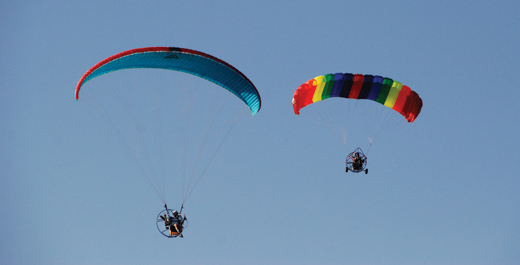
Both powered paragliders and powered parachutes will compete at the World Paramotor Championships.
Playing to Win
Most people believe that the only reason for participating in a competition is to win. And if you are competing in the Olympics, I suppose that is true. However, a more realistic and positive point of view, particularly for first-time competitors, is to approach it like the Jamaican national bobsled team, made famous by the 1993 movie Cool Runnings. It’s important to understand that Europeans take competition very seriously. Some teams practice every weekend, and many attend a host of national and international events where they can hone their competition skills. It is unlikely that a first-time competitor is going to be able to top that kind of preparation. With that in mind, be prepared to enjoy the experience rather than focusing on a gold medal. (And, yes, they do hand out gold, silver and bronze medals.)
In fact, Americans who show up at microlight competitions are treated very well because it is rare for an American to participate (likely due to the few competition opportunities here in the U.S. coupled with the expense of participating in a European event). But the bottom line is that if you show up and make an honest effort to do your best, you will make a lot of new friends and may even decide to try your hand at future competitions in other countries.
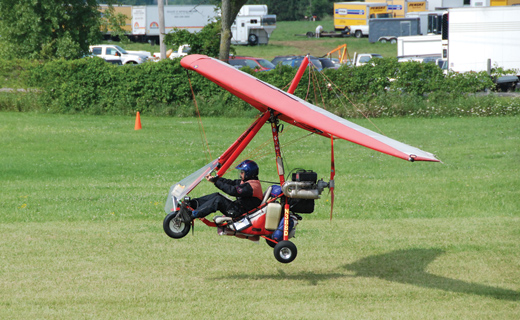
Twice now, Dan Grunloh has competed in world championship events with his trike.
Learning the Rules
International competitions, by definition, have international rules. The good news for Americans is that all of these rules are in English. In fact, all of the flight briefings are in English, and many of the people you’ll meet know some English and will happily to practice their language skills on funny-sounding Americans. (They think British English is normal, for some reason.) In aviation, English is the accepted language.
The competition rules are published in advance, and it is a good idea to review them ahead of time. There are two important documents to familiarize yourself with. The first is Section 10 of the FAI Sporting Code, the overall set of rules for microlights. It has a lot of information, but pay close attention to Chapter 4 (Championships), Chapter 5 (Control & Measurement) and Annexes 3 and 4, which are part of a separate document and offer a task catalog for events. You won’t see all of the tasks in the task catalog at a championship and some of them will be changed or even new, but it is a great place to get started. Section 10 and the annexes can be found on the FAI web site, www.fai.org. The menu will point you in the right direction.
The next document you’ll need is the local rules published by the hosting country’s organizers. They are more detailed in some cases, and pertinent to the competitions they’re hosting. And did I mention that those rules are in English? The local rules for the 2012 World Microlight Championship (WMC) held this summer can be found at https://sites.google.com/site/wmc2012spain/official-documents and those for the 2012 World Paramotor Championships (WPC) are at http://sites.google.com/site/wpc2012spain/official-documents.
The FAI places a lot of weight on three separate disciplines in World Championship events. While U.S. competitors are used to performing precision tasks such as spot landings, quick takeoffs, and other maneuvers that can be performed in the vicinity of the airport, international rules add two more tasks: cross-country and efficiency. And when FAI says cross-country, they mean old-fashioned sectionals and plotters—no GPS allowed. Efficiency requires burning as little fuel as possible on a cross-country trip. This can result in two winners for a particular task: the pilot who got the best time and the pilot who burned the least amount of fuel. If a takeoff or landing task is thrown into the mix, you could have three winners. Just as often, a formula will take into account all three factors in the final scoring. Either way, a World Champion is no one-trick pony. That pilot has to demonstrate excellence in a variety of skills.
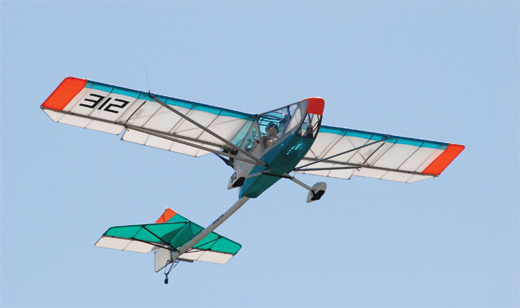
Steve Bensinger has previously competed with his Hawk. Hawks have done well in past championships.
Getting Signed Up
In many European countries, being a member of a competition team is a coveted position, and national competitions are held to select them. Outside of Europe, the competition is not so fierce. And in the U.S., a spot on the team is pretty much there for the asking. But whom do you ask?
The first organization to approach is the United States Ultralight Association (USUA, www.usua.org), but you’ll need to be a member. You will also need a sporting license, which can be obtained from the National Aeronautic Association (NAA, www.naa.aero).
The dates for the 2012 WMC event are August 11-18, but it is a good idea to arrive as early as August 7, the day the official training period starts, in order to get acclimated, register, check out your aircraft, and fly. The WPC championship will be held at the same location, following the WMC. The competition dates are August 26-31, but again, it is a good idea to arrive early as August 21 for the same reasons.
The entry fee for pilots and copilots are €450 each (about $580 at the time this was written). For that $580, you’ll be allowed to participate in the competition and receive all competition materials (maps, task descriptions, control point atlases, etc.). You’ll have free use of the airport and free entry to all official events. Camping with water and electricity is also free, and you’ll receive discounts on meals. Not a bad deal for an 11-day stay in Spain. Camping at the airport is common and you won’t really be roughing it as the airport has a large in-ground swimming pool and probably beer tents open into the late hours. (Not recommended before flying days!)
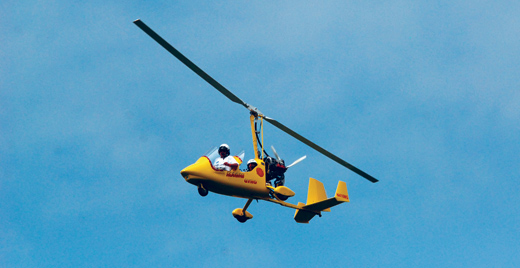
This year, for the first time, gyroplanes will be able to officially compete at the World Microlight Championships.
What to Fly When There
This is the most difficult part of the adventure. Plane tickets are expensive, and getting a container large enough to ship your aircraft to and from the event can be a financial challenge if you fly an airplane, a gyroplane or a trike. The foot-launch competitors have an easier time because their equipment packs down so small. But still, it is an expense.
Even if money is no object, losing your airplane for the weeks that it takes to transport it is a burden if you want to practice for the event before your travel. A little bit of creativity and work can make this part of the process a little less painful, and there are several tactics you can employ.
• Find sponsors: Money is tighter than ever, but that doesn’t mean you can’t find someone to help you out. Your first stop may naturally be the builder of the aircraft you fly. If it has European origins, you may be able to network and get someone there to lend or rent you their plane for far less than the cost to ship yours. If your airplane is built in the U.S., the manufacturer may have European contacts and/or be able to help out directly. Remember, having an aircraft at the world championships is good for business. And the higher you place in the standings, the more likely you are to have more help the next time you want to compete.
• Solicit contributions: Clubs, local companies and fans of the sport may be willing to contribute in some way. Transportation is the biggest challenge, so contact someone in that business. It may be a sponsorship arrangement made in heaven. The key is to recognize the situation early and attack it head-on.
Enjoying the Trip
The most important thing about competing at the world level is to remember that you are experiencing what may be a once-in-a-lifetime adventure. Go to the event and wake up each day expecting to enjoy it. Your time there will be measured in days, but the memories you create will last a lifetime.
If you plan to attend the World Paramotor Championships, you will already have one friend on site: I will be there acting as the president of the FAI Jury. I’m looking forward to the trip and the opportunity to work with my friends in Europe, but it would be great to have someone else there who knows what the Three Stooges and steakhouses are all about.

![]()
Roy Beisswenger is the technical editor for Powered Sport Flying magazine (www.psfmagazine.com) and host of the Powered Sport Flying Radio Show (www.psfradio.com). He is also a Light Sport repairman and gold seal flight instructor for Light Sport Aircraft as well as the United States delegate to CIMA, the committee of the Fédération Aéronautique Internationale (FAI) pertaining to microlight activity around the world.



